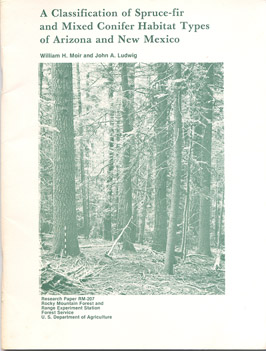 U.S. Department of Agriculture, Forest Service, Research Paper RM-207, Rocky Mountain Forest and Range Experiment Station, Fort Collins, CO, July 1979, 47 pages, black-and-white photgraphs, maps
U.S. Department of Agriculture, Forest Service, Research Paper RM-207, Rocky Mountain Forest and Range Experiment Station, Fort Collins, CO, July 1979, 47 pages, black-and-white photgraphs, maps
|
Contents
| |
|
INTRODUCTION
STUDY AREA METHODS FIELD SAMPLING DATA ANALYSIS RESULTS AND DISCUSSION DESCRIPTION OF SPRUCE-FIR HABITAT TYPES Picea engelmannii Series Abies lasiocarpa Series DESCRIPTION OF MIXED CONIFER HABITAT TYPES Picea pungens Series Abies concolor Series Pseudotsuga menziesii Series SPRUCE-FIR FOREST: OTHER HABITAT TYPES MIXED CONIFER FOREST: OTHER HABITAT TYPES SUMMARY AND CONCLUSIONS LITERATURE CITED APPENDIX PLANT LIST KEY TO THE HABITAT TYPES BY REGION Table A-1. Dynamic status of trees Tables A-2 to A-5. Species importance values by habitat type |
1
1 4 4 5 5 7 7 8 15 15 20 26 27 27 28 29 31 31 35 39 40 |